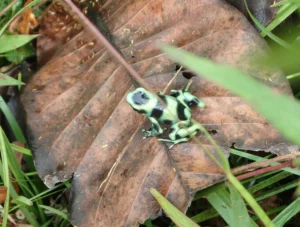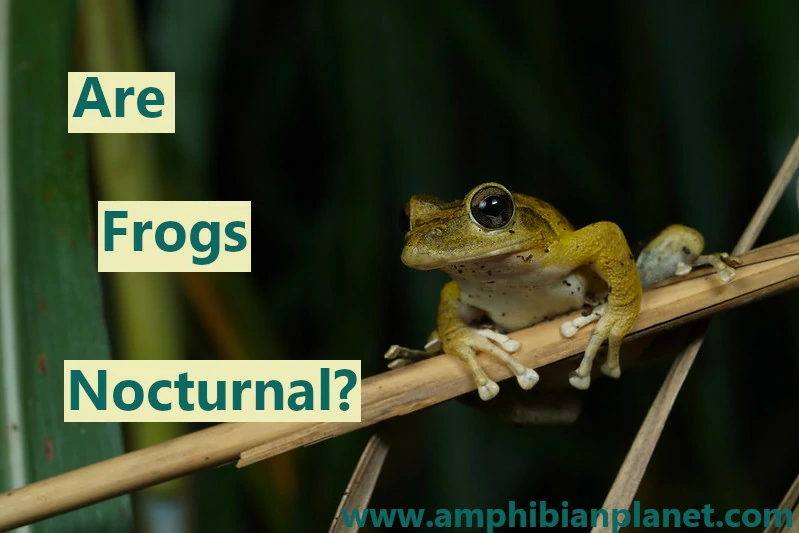On warm nights in the wet season, frogs come out of their daytime retreats to call and look for mates. It’s common to hear the croaking of hundreds of hidden frogs – coming from ponds, and other bodies of freshwater nearby. When the sun comes up, the croaking stops, and the frogs go back to their daytime retreats.
The majority of frog species are either nocturnal or crepuscular and are most active at night or in the low-light hours right before the sun rises and sets. However, a few species, most notably, poison dart frogs, are diurnal, meaning they’re most active in the daytime.
A nocturnal lifestyle is advantageous to frogs, and many other animals.
Many of the animals that prey on frogs are less active at night, making it safer for frogs to come out and search for food.
There’s also less competition for resources. Fewer creatures are looking for a drink of water or on the hunt for prey at night, which means frogs have a better chance at success.
Most Frog Species Are Either Nocturnal Or Crepuscular
All animals are either diurnal, nocturnal, or crepuscular. Humans are diurnal creatures, meaning we are primarily active in the daytime and sleep at night.
Most frogs on the other hand are nocturnal or crepuscular. This means they are most active at when the sun is down, or in the low light hours right before the sun rises or sets.

Frogs have several distinctive anatomical features suited for their nocturnal, or crepuscular lifestyle.
For one, frogs have excellent night vision that is thought to be superior to all other animals (including animals with excellent night vision such as cats and owls), and they can see color even in extreme darkness, where humans are not able to see anything.
The positioning of frogs’ eyes atop the head, gives them a very wide range of vision. They can see in front, to the sides, and partially behind them.
This peripheral vision, along with excellent night vision, helps frogs spot predators and search for food in low-light conditions.
7 Reasons Why Most Frogs Are Nocturnal
As earlier mentioned, a nocturnal lifestyle is advantageous to frogs, and many other animals. The conditions at night provide the perfect environment for frogs to come out of their daytime retreats.
1. Frogs Are Less Vulnerable To Predators At Night
Frogs feel more comfortable at night because they’re not as easily visible to potential predators. Many of the animals that prey on frogs are less active at night, making it safer for frogs to come out.
For example, many predatory bird species such as hawks, and eagles are strictly diurnal, meaning they don’t hunt at night.
This allows frogs to come out more into the open without the fear of being eaten by hawks, and many other predators.
While there are also predators at night, frogs can blend into their environments more easily and have a better chance of going unnoticed in the cover that the darkness provides.
2. Frogs Can Search For Food At Night
Many of the insects that frogs prey on, such as crickets, are usually active at night, remaining hidden during the day. This means nighttime is a good time for hunting.
In addition, frogs hunt more easily in low light conditions and avoid being seen by the prey.
3. There’s Less Competition For Resources At Night
Frogs hunt the same prey as many other animals. They also use water sources that are used by other animals.
Being nocturnal helps frogs avoid conflict with many animals. Fewer creatures are looking for a drink of water or on the hunt for prey at night, which means frogs have a better chance at success.
4. Night Because The Temperatures Are Cooler
Frogs are ectothermic (cold-blooded) animals, which means they cannot regulate their body temperature. Their body temperature changes with that of their surroundings.
When it’s warm, their bodies soak up the heat, and their body temperature rises. When it’s cooler, their body temperature falls.
In other words, they depend on their environment to keep them comfortably cool or warm.
As the temperature changes at different times of day, they move around in their environment to regulate their body temperature.
When their body temperature is low, they move into the sun to warm up, when it is high, they move to the shade or cool water to cool down.
Night temperatures are usually cooler because the sun is not out at night. The ground cools because it emits more radiation than it gains from the atmosphere.
This means frogs can come out and be more active without the fear of overheating. The cool night weather is perfect for them to emerge from their daytime retreats.
5. Frogs Can Conserve Water At Night
Frogs love cool, humid environments. They usually hang around shaded areas near ponds, swamps, streams, lakes, and other water bodies – where they can cool down and keep their skin moist.
Relative humidity increases at night due to the drop in temperature, so frogs can come out without worrying about their skin drying out.
In simple terms, the air is like a sponge. When air temperature increases, the air capacity increases, so the air can hold more water vapor.
However, as the air temperature drops, the air capacity decreases, so the air can hold less vapor. This leads to an increase in relative humidity.
6. Frogs Can Search For Mates At Night
The cooler nighttime temperatures, higher humidity, and fewer predators provide the perfect environment for male frogs to call to attract females with whom to mate. This is especially true during the wet season when most frogs reproduce.
Males usually call from ponds, swamps, streams, and other possible breeding sites. Each frog species has a different call and female frogs will only be attracted to the call of their own species.
When females are ready to mate, they will move towards calling males, and pick the male that they prefer.
7. Frogs Can Avoid Interaction With Humans At Night
As earlier mentioned, humans are diurnal creatures, meaning we are primarily active in the daytime and sleep at night.
A nocturnal lifestyle allows frogs to avoid many potentially dangerous encounters with humans.
Some Frogs Are Diurnal
Although most frog species are nocturnal, there are some exceptions. For example, Poison dart frogs native to the tropical rainforests of Central and South America, are diurnal. This means they’re most active in the daytime – just like us humans.

Since these frogs live in tropical rainforests, the environmental humidity is consistently high, so they can be active during the day without worrying about keeping their skin moist.
In addition, most poison dart frogs live on, or very close to the floor, where much of the direct sunlight is absorbed by the foliage.
This means they do have to worry about overheating, even in the middle of the afternoon when the sun is directly overhead.
Also, poison dart frogs produce poisonous secretions that make them distasteful or lethal to most predators. For this reason, they do not have many natural predators. They can be active during the day without worrying about being preyed on by other animals.
To warn predators of their toxicity, poison dart frogs often sport bright or contrasting colors. This is known as ‘aposematism’ or ‘warning coloration’.
Think of it like holding up a sign that says “Stay away from me, I’m poisonous!”
An animal that eats a brightly colored poison dart frog will get very sick (or even die) and remember the experience.
The next time the animal sees another similarly colored frog, it will associate the coloration with danger and learn to avoid that particular species.
Conclusion
The vast majority of frog species are primarily either nocturnal, or crepuscular meaning they are most active when the sun is down, or in the low light hours right before the sun rises or sets.
Frogs have several distinctive anatomical features suited for this lifestyle, one being an excellent vision in low-light conditions.
Being nocturnal helps frogs avoid the heat of the day, and also many predators such as hawks that are active during the day.
A handful of frog species are diurnal and are most active in the daytime. However, being diurnal is quite rare for frogs, so you can be sure most of the frogs you see in the wet season are nocturnal.


